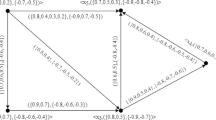Abstract
Based on the principle of discernibility matrix, a kind of reduction algorithm with attribute order has been developed and its solution has been proved to be complete forreduct and unique for a given attribute order. Being called thereduct problem, this algorithm can be regarded as a mappingR=Reduct(S) from the attribute order space⊝ to thereduct spaceR for an information system (U, C∪ D), whereU is the universe andC andD are two sets of condition and decision attributes respectively. This paper focuses on the reverse problem ofreduct problemS=Order(R), i.e., for a givenreduct R of an information system, we determine the solution ofS=Order(R) in the space⊝. First, we need to prove that there is at least one attribute orderS such thatS=Order(R). Then, some decision rules are proposed, which can be used directly to decide whether the pair of attribute orders has the samereduct. The main method is based on the fact that an attribute order can be transformed into another one by moving the attribute for limited times. Thus, the decision of the pair of attribute orders can be altered to the decision of the sequence of neighboring pairs of attribute orders. Therefore, the basic theorem of neighboring pair of attribute orders is first proved, then, the decision theorem of attribute order is proved accordingly by the second attribute.
Similar content being viewed by others
References
Wang Jue, Wang Ju. Reduct algorithms on discernibility matrix: The ordered attributes method.J. Computer Science and Technology 2001, 16(6): 489–504.
Skowron A, Rauszer C. The discernibility matrices and functions in information systems. Intelligent Decision Support Handbook of Applications and Advance of the Rough Sets Theory, Slowinski Ret al. (eds.), 1991, pp.331–362.
Pawlak Z. Rough sets.Int. J. Comput. Inform. Sci., 1982, 11(5): 341–356.
Author information
Authors and Affiliations
Corresponding author
Additional information
This work is supported partially by the National Grand Fundamental Research 973 Program of China (Grant No.G1998030500), and the National Natural Science Foundation of China (Grant No. 60273024 and the National “863” High-Tech Programme, of China (Grant No. 2001AA114170).
Su-Qing Han received the B.S. and M.S. degrees from Shanxi University, Shanxi, China, in 1986 and 2000 respectively. She is currently a Ph.D. candidate in the Institute of Automation, the Chinese Academy of Sciences, and also a teacher in the Department of Mathematics, Taiyuan Normal College, Shanxi, China. Her current research interests include rough sets, machine learning and data mining.
Jue Wang is a professor of computer science and artificial intelligence at the Institute of Automation, the Chinese Academy of Sciences. He graduated in computer science and artificial intelligence from Graduate School, Univ. Science and Technology of China in 1981. Wang's research interests include knowledge representation, expert system, artificial neural network, genetic algorithm, knowledge discovery in databases and methodology in AI.
Rights and permissions
About this article
Cite this article
Han, SQ., Wang, J. Reduct and attribute order. J. Compt. Sci. & Technol. 19, 429–449 (2004). https://doi.org/10.1007/BF02944745
Received:
Revised:
Issue Date:
DOI: https://doi.org/10.1007/BF02944745




